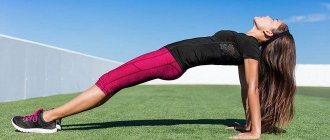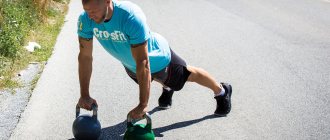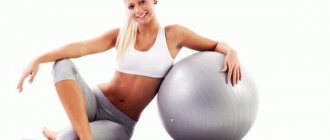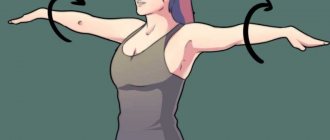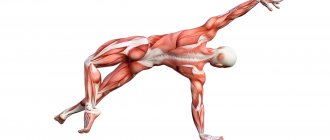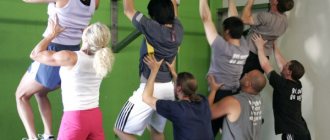Making a steel lower back. The best exercises for pain and heaviness in the lower back
Pain and heaviness in the lower back are a common side effect of basic exercises like deadlifts and squats.
Also, the lower back can hurt from sitting for a long time in the office, from a complete lack of load, and even from stress. “Soviet Sport” has collected the best exercises for the lower back. They will allow you to forget about unpleasant sensations and make your lower back muscles stronger. The whole set of movements will take about 10 minutes, and you can perform it at home, without having any exercise equipment at all.
Crunches
We lie down on our backs. We bend our legs at the knees and place them on the floor, with our arms outstretched to the sides. As you inhale, turn your legs bent at the knees to the left until your knee touches the ground. At the same time, twist the torso to the right. We stay in this position for 2-3 seconds. As you exhale, we return to the starting position. Next inhale – lower your legs to the right, twist your torso to the left. Repeat approximately 8-10 times in each direction.
Cat arching
We get down on all fours. As you inhale, bend your back in the spine - hold for 2-3 seconds. As you exhale, round your back as much as possible and lower your head. We fixate for 2-3 seconds. We repeat the exercise 10-12 times.
Lowering the pelvis to the sides
From a standing position on all fours, we begin to smoothly lower the pelvis to the right and left (preferably until it touches the floor). We do not lift our knees off the floor, our feet remain on the floor. 10-12 times in each direction.
Back extension
This exercise is an analogue of hyperextension (“hyperextension”). It perfectly stretches the spine and strengthens the lumbar muscles. Lie on your stomach with your hands on the floor at chest level. As you exhale, straighten your arms, arch your back and tilt your head slightly back. We fixate for 2 seconds in this position, then lower ourselves to the floor again. Repeat 7-10 times.
Leg and knee raises
We lie down on our backs. Raise your legs bent at the knees in front of you. As you inhale, gently pull your knees towards your chest (help yourself with your hands): we feel the tension in the muscles of the lower back. As you exhale, lower your knees.
We repeat 8 times, then move on to raising the legs: straighten the legs and place them on the floor. As you inhale, slowly raise one leg up in front of you, without bending it - as much as possible. As you exhale, lower it. We repeat the movement with the other leg, 8-10 times on each leg.
Bends towards the leg
We sit on the floor, straighten one leg, and place the other under us. As you exhale, stretch your arms and torso towards the toe of your foot. We try to grab the toe with our hands and stay in this position for 1-2 seconds. Repeat 8-10 times, then change legs.
Hanging and twisting on the horizontal bar
The usual hang on the horizontal bar stretches the spine well - this is especially useful if you have done deadlifts. Hang on the horizontal bar without moving, arms and legs fully straightened. Hang for 25-40 seconds, then carefully step on the ground - do not jump off the horizontal bar to avoid muscle strain. Repeat 2-3 times.
While hanging, do small twists with your body to the right and left. Repeat 10 times on each side.
Other recommendations for preventing back pain:
- Perform this complex daily. You can do it in the morning immediately after waking up (instead of morning exercises) and in the evening;
- On the day of deadlifts or squats, do this back routine instead of a cool-down. Complete your workout with it;
- reduce the range of motion if you feel pain;
- Warm up well before performing heavy basic exercises. Include hyperextensions and barbell crunches in your program. Hyperextensions can be performed before the main exercise - do them first without additional weight, 12-15 repetitions per set. The purpose of hyperextensions is to stretch and stretch the lumbar muscles, preparing them for work;
- After deadlifting, do exercises that will help stretch your spine. Regular pull-ups or lat pull-downs are best;
- if you have trouble recovering from deadlifts, do this exercise less often. For example: one week you do deadlifts, and the other week you do without it;
— increase the weights in basic exercises gradually and watch the technique. Do not increase the weight on the bar if you performed the exercise with less weight but poor technique.
Before starting training, consult your doctor!
Effective exercises for women and men
The structure of muscles is the same in men and women. Therefore, they should work out their lower back in the same way in the gym or at home. Exercises are selected taking into account not gender and age, but goals: relaxation and stretching, pumping, treatment.
Complex for lengthening muscles
Abdominal pumping - twisting
The goal of the training program is to stretch the shortened muscle and relieve spasm. Yoga exercises are perfect for this purpose. Stretching is performed in different directions.
Before you take a static pose or begin movement, you need to create an initial stretch in the spine. For example, if an exercise is performed standing, at the beginning the athlete stretches his body up, perhaps raises his arms to enhance the sensation, and only then performs bends, twists, etc.
- Twisting – perform a gradual twisting from a standing position. First, lower the head with the chin to the chest, then twist the chest, bend, rounding the lower back and at the same time bending over, slightly bend the legs at the knees and lower the body until it assumes a free hanging position. They are also gradually rising. If the pain in the lower back is severe, when bending over, rest your hands on your legs to reduce the load.
- Cat - standing on all fours, round and straighten the back. The lower back follows the movement of the thoracic spine, and not vice versa. It's better to keep your head down. Exercise, when performed correctly, quickly relieves pain.
- The dog is a static yoga asana that stretches the quadratus and lumbar muscles, biceps and calves well. The pose requires some physical preparation.
- Half-bridge - lying on your back, place your feet as close to your buttocks as possible and lift your pelvis up, resting on your feet and shoulders. The distance between the buttocks and feet is determined by the degree of shortening of the psoas muscle. A flexible girl can start straight away from the bridge.
- The plank is reverse. In a sitting position with legs extended forward, rest your palms on the back of your body and lift your pelvis up, while simultaneously bending your knees. Keep the body level on your arms and bent legs for 30–60 s.
Lengthening exercises at the next stage of training are performed at the end of the session to relax strained muscles.
Strength exercises

Hyperextension on a fitball helps pump up the side muscles of the waist and back
It is somewhat more difficult to pump up the muscles of the lower back and back at home than in the gym. The core muscles are designed to support at least the weight of your body, and for training the load must be higher than usual.
- Seated corner - while sitting, bend your knees, lean back a little to maintain balance, raise and straighten both legs at your knees. Hold the corner for at least 10–15 seconds.
- Hyperextension - can be performed on a bench, floor, fitball. The amplitude in this case is limited, but the psoas muscle is partially pumped. You can make a “boat”.
- Hanging crunch – performed on any bar. In the starting position, raise straight or slightly bent legs, twisting in the back, and not using the abdominal muscles.
- Pull-ups - the option with weights is especially effective. But even trying to do the exercise bears fruit.
- Deadlifts are the best option for pumping up the lower back. At home, the barbell is replaced with dumbbells. It is extremely important to follow the technique here, so you need to study the exercise with a trainer.
The complex should include abdominal exercises. Antagonist muscles are just as important to support the lower back as your own.
To build muscle, you need to change your diet and include enough protein.
Lower back exercises
The psoas muscles are the spinal erectors. Visually, they give the torso a powerful rear view, and functionally, with heavy loads on the legs and back, they reduce the likelihood of injury. A trained lower back, as well as correctly selected exercises for the lower back, prevents the occurrence of diseases associated with displacement of the vertebral discs and pinched spinal nerve roots. For an athlete, a powerful lower back is always a strong muscular frame that holds the spine in the correct position.
In a training set of exercises for the back, it is recommended to put work with the lumbar erectors last. These are quite strong and resilient muscles, accustomed to significant stress in everyday life. To strengthen the lower back, it is necessary to perform exercises for the lower back, such as front bends with a barbell on the shoulders and hyperextensions. If you want to build a powerful and massive back, then include deadlifts in your training program.
Exercises for the back and spine
Complexes of therapeutic and restorative physical education can be performed both in specially designated places and at home. It is important to pay attention to the correct execution of movements, control of amplitude, working weights and frequency of exercise. All necessary information can be obtained from a sports instructor or attending physician.
Workouts in the gym
Modern sports clubs and fitness centers usually have gyms that have everything necessary for high-quality training of the back muscles. All exercises can be divided into two types:
- Basic:
- Deadlift. This is lifting a barbell from the floor or small platform. It works all areas of the back (including deep muscles), buttocks and thigh biceps, which is why girls are very fond of it.
- Bent-over barbell row. Strengthens not only the latissimus, rhomboid, serratus, infraspinatus muscles, but also the deltoid (back) and lumbar muscles.
- Wide grip pull-ups. Can be performed both to the chest and behind the head. In the process, all the muscles of the upper back work, which helps to expand it and give the body a V-shaped appearance. Against this background, the exercise is not held in high esteem by the fair sex.
- Auxiliary:
- Exercises with dumbbells. Various types of rows, performed bent over and with emphasis on the bench, work the latissimus muscles. While standing, they do shrugs - raising the shoulders to the ears, allowing you to load the trapezius muscle.
- Block pull. Can be performed to the chest, behind the head, to the stomach, with grips of various widths. By varying these parameters, we achieve an emphasis on the load on the top, middle or bottom of the lats. Block simulators allow you to safely work out almost all areas of the back, but one at a time.
- Exercises for the lower back. The lumbar region is worked out by performing hyperextensions (extension of the body on a special bench with fixed legs) and bending with a barbell (bar) on the shoulders.
Photo gallery: basic and auxiliary exercises to strengthen the back muscles in the gym
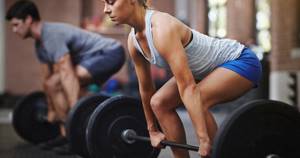
Deadlift allows you to work all the back muscles
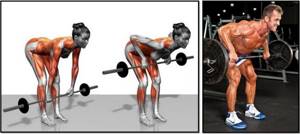
Bent-over barbell rows load the lower and middle back
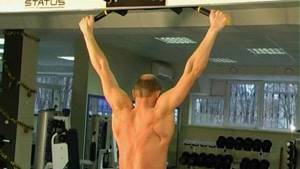
Pull-ups make your back wider, giving it a V-shape.

The lat pull-down is one of the most popular auxiliary exercises for the back.
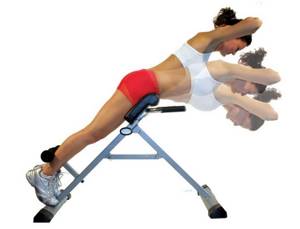
Raises effectively work the lower back muscles
If you train on your own, remember: almost all strength exercises for the back should be performed with an arched lower back (pelvis laid back) and a straight spine in the upper and middle sections (chest protruded, shoulder blades closed, shoulders down). This will protect you from injury during training and make it more productive.
Video: back training in the gym
Visit to the swimming pool
If you want to increase muscle mass or strength, you shouldn't consider the pool as a priority option. Swimming perfectly strengthens the cardiovascular and respiratory systems, increases general and special endurance, and tones almost all the muscles of the body, including deep ones, which are almost impossible to work in other ways. But it is not suitable for increasing muscle volume.
During swimming in a calm mode, about 400–600 kcal are burned in forty-five minutes. If we are talking about intense swimming, the figure increases by one and a half times and is 25% higher than the same energy loss during fast running or aerobic training in the gym.
Doing water exercises is a great way to lose weight. A swimming pool is a place where it’s easy to combine business with pleasure. Another undeniable advantage of water exercises is its amazing therapeutic effect. Swimming is indicated for people suffering from diseases of the joints and spine; it is prescribed to treat existing diseases and prevent the emergence of new ones.
All special exercises for strengthening/toning the back muscles in water can be divided into the following groups:
- Pulling. For therapeutic purposes, they suggest the use of traction equipment, but gentle variations allow you to stretch the spine by various kinds of hanging on dividing ropes or stairs into the pool; some types of swimming (mainly on the stomach, characterized by long sliding movements) also promote traction.
- Activating blood and lymph flow. Underwater swimming, in which movement is carried out through short wave-like movements of the entire torso and limbs (“dolphin-like”), copes with this task more effectively than others. This style improves spinal mobility and helps eliminate muscle spasms.
- Strengthening the muscle corset. In the context of the muscle groups located on the back, the most effective method is breaststroke swimming. In the process, there is an alternation of dynamic and static stresses of almost all back muscles (including deep ones) with natural relaxation, which has a very beneficial effect on the general physical condition of the swimmer.
- Therapeutic. Specialists select a set of exercises (depending on the diagnosis, nature and extent of damage to cartilage/muscle tissue) aimed at dynamic and static stretching of fascia, tendons, muscles, toning them and imparting elasticity.

Water exercises relieve stress on the back muscles, promoting spinal traction
Scientists have proven that the safest, most beneficial form of physical activity for most muscle groups (including the back muscles) and accessible to representatives of almost all age groups is swimming.
Video: breaststroke is a great workout for all back muscles
General exercises
You can strengthen your back muscles not only in the gym; in the absence of time, free funds and the desire to go to a club for training, health/general strengthening complexes can be successfully performed at home and even at the workplace during your lunch break (if conditions allow). Universal exercises can be divided into four types:
- Without special equipment:
- Various types of lifts of the body and limbs while lying on the stomach. The most famous exercise is “superman”. To perform it, you need to lie on your stomach and simultaneously lift your arms, legs and head off the floor, arching your back. You should hold the position for ten seconds.
- Deep push-ups with arms wide apart. To stretch the pectoral muscles well and work the lats, place your palms on elevated surfaces (dumbbells, books, etc.). The optimal width of the arms should be such that in the lower phase of movement a right angle is formed at the elbow joint.
- Leg and pelvic lifts while lying on your back. This strengthens not only the lower abs, but also the lower back muscles and spinal stabilizers. The power phase of the movement is done while exhaling, it should be performed twice as fast as the negative repetition.
- "Plank". This exercise deserves special attention. To perform it, you need to take a horizontal position on the floor, leaning on your toes and elbows. It is important that the entire torso is straight. By exercising regularly, you can strengthen almost all the muscles (and especially the tendons) of your back. Statics does not contribute to the growth of muscle tissue, which makes the exercise ideal for girls who want to be in shape, but value their visual fragility.
- With available tools:
- Water bottles. Successfully replace dumbbells and weights. With their help, you can perform bent-over rows (make sure your lower back is always arched), shoulder-to-ear raises (strengthen the trapezius muscles), and arm raises to the sides while lying on two stools with your back up (they strengthen the upper back well).
- Stools. Used as an improvised bench, platform, parallel bars. By placing two chairs together, you get an excellent push-up apparatus. By varying the distance between them, you can achieve different areas of the back. It is important to perform push-ups with your arms spread out to the sides (you should be between the stools). The straightened legs rise, forming a right angle with the body (this also works the abdominal muscles).
- Door jambs and openings. Suitable for performing static exercises, pull-ups and deep push-ups while standing. If you want a wide back, there is nothing better than pull-ups. The door frame is quite suitable for their implementation. It's not very comfortable to grab onto, but it will greatly strengthen your hands and fingers. Make sure your arms are wide apart, otherwise your biceps will come into play. In a doorway, you can perform bent-over push-ups and static stands (like a plank, but with your hands at the ends of the doorway).
- With sports equipment: Fitness ball. It does not take up much space, but with its help you can do a lot of exercises for the back (bridge, straight and side plank, hyperextension, various types of twisting). It is suitable for almost all static exercises performed on the floor, increasing their complexity many times over.
- Dumbbells. They allow you to work out individual muscle groups through various lifts (standing, inclined, lying on chairs with your stomach down). The ideal option is collapsible varieties. Using them, you can systematically increase the load.
- Rubber bands and expanders. They can easily replace block exercise machines; they can be used to do various types of deadlifts. To perform them, take the free ends in your hands, and step on the middle with your foot or fasten it to the wall/ceiling/door frame.
- Gymnastic stick. Allows you to maintain the desired angles when bending, rotating, twisting. They mainly perform exercises to stretch muscles, ligaments, and tendons.
Photo gallery: general exercises
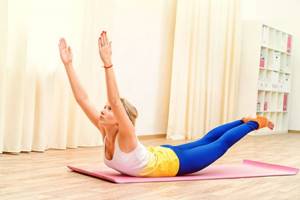
The “superman” exercise is one of the basic and most effective of those performed on the floor.

“Plank” allows you to work all the muscles of the back and abdominals
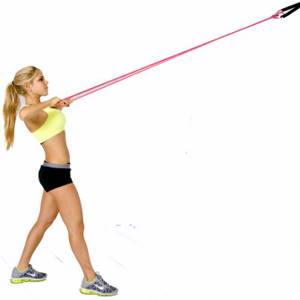
Exercises with a rubber band are an excellent alternative to working on block machines.

You can very comfortably work on strengthening your lower back on a fitball.

Lying leg raises strengthen the lower abs and lower back well.
Video: how to strengthen your back muscles at home
I work in an office. Every two hours I look up from the computer and, instead of taking a traditional smoke break, do a series of simple exercises: stretching, bending (forward, backward and sideways), alternately raising/lowering my arms in a vertical plane (with my back pressed against the wall), squeezing and spreading my shoulder blades (while bending /bending the body), I squat with my legs spread wide. This allows me to always be in good shape; I also stopped experiencing back pain a long time ago.
Video: simple exercises for office workers
Lower back exercises – Hyperextensions
This exercise is recommended for beginner athletes and people with weak or previously injured backs. It targets the psoas, glutes and hip flexors. It is performed on a special simulator - a Roman chair.
If you don’t have this sports equipment, you can use a bench press and the help of a partner who will hold your legs in the thighs or shins. You can also perform this exercise on a gymnastic ball (fitness ball).
Technical nuances of performing the exercise on a Roman chair:
1. Lie down on a Roman chair with your stomach down, placing your heels under a bolster to support your feet.
2. Initial position: the body from heels to head is a straight line. The edge of the machine bench should be 5/10 cm below groin level. Arms crossed on chest.
3. Tilt (bend) the torso down 90º degrees relative to the legs.
4. Return (unbend) the torso to its original position. We linger in it for 1/1.5 seconds. You should not do excessive extensions in the lower back.
- Eliminate the force of inertia in your movements.
- Perform full amplitude slow controlled flexion and extension.
- Do not round your back - this puts the load on your buttocks.
- Inhale as you go down and exhale as you go up.
Exercises to strengthen the quadratus dorsi muscle without axial load on the spine
The following exercises are considered safe for people with back problems.
Complex without axial load for the quadratus lumborum muscle
| Exercises | Sets | Repetitions/Time |
| Reverse hyperextensions at home | 3 | 10 |
| Deadlift with dumbbells | 4 | 15 |
| Hyperextensions at home | 3 | 12 |
| Straight-legged dumbbell row | 3 | 15 |
| Quadratus lumborum boat | 2 | 15 |
| Boat with alternating cross lifts of arms and legs | 3 | 12 |
| Quadratus lumborum plank | 3 | 60 seconds |
Reverse hyperextensions at home
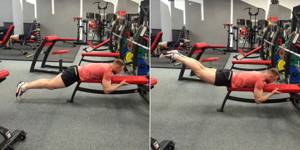
Technique:
Initial position:
Lie on the table with your stomach so that your pelvis protrudes beyond the base. Use a gymnastics mat, placing it on top of the table. Hold onto the ends of the tabletop. The legs are suspended.
- Raise your legs, exhaling as high as possible. The load can be adjusted by bending your knees. The more they are bent, the easier the exercise.
- Lower your legs. Inhale the air.
How many:
3 sets of 10 reps.
Read: Complex: healthy spine and lower back
Hyperextensions at home
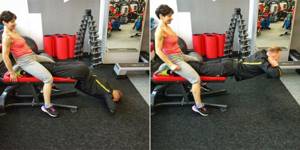
Technique:
Initial position:
Find a flat surface. For example, a sofa, bed or table. It would be a good idea to do the exercise with a partner who will hold your legs. If you don't have a partner, a heavy backpack will do for counterweight. Lie on your stomach on the bed so that your pelvis protrudes slightly forward. Place a counterweight on your feet or have a partner sit on you. Keep your body horizontal to the floor, fold your arms in front of you.
- Lower your upper body to the floor and exhale.
- As you exhale, rise to the starting position.
Number of repetitions:
3 sets of 12 times.
Exercise "Boat" for the quadratus dorsi muscle
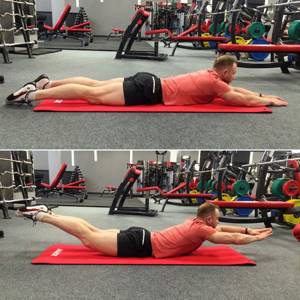
Technique:
- Lie on the floor with your stomach on a gymnastics mat.
- Bend your spine as much as possible, stretching your arms and legs up. Keep your limbs straight.
- Hold for 2 seconds and lower to the starting position.
Number of repetitions:
2 sets of 15 lifts.
Read: How to do the “Boat” exercise on your back at home
Another exercise option
There is another option for performing the exercise. With alternate cross lifts of arms and legs. You can do it by analogy with the previous boat.
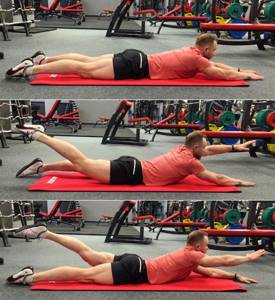
Read: How to do a narrow barbell row to the chin on the upper back
Plank for quadratus lumborum muscle

Front bends with a barbell on the shoulders
This type of bending with weights works well for the lumbar erector spinae. When performing it, additionally, the leg muscles (hamstrings and buttocks) receive an excellent load. This exercise can be done sitting on a bench or standing.
For girls or those whose back muscles are not yet sufficiently developed, it is better to use the first option and perform bends with an empty bar.
Technical nuances of performing front bends with a barbell on the shoulders while standing:
1. Take the weight with a wide grip (from above), lift it above your head and place it on your trapezius.
2. Place your feet shoulder-width apart, straighten your back, slightly bending it in the lower back, bring your shoulder blades together and slightly bend your knees (if your legs are straightened all the way, then the largest part of the load will go to the hamstrings).
3. Slowly tilt the body forward and at the same time move the pelvis back.
The tilt of the torso should be done through the hip joint, and not through the lumbar spine.
4. Lower the body strictly until it is parallel to the floor and lift it back. At the same time, the pelvis should be pulled forward.
5. After passing the heaviest point of the climb (you will feel it), begin to take a deep breath.
6. Return to the starting position and, as you exhale, repeat the movement.
About strengthening the lumbar muscles
In this article I will depart from my usual style and write everything in the first person. I had a problem, one day I got osteochondrosis of the lower back while skiing. It hurt like hell, my nerves were pinched.
11 years have passed since then, today my working deadlift weight is 140 kg. Without any pharmacology, exclusively natural. And my back doesn't hurt. I'll tell you how to strengthen your lower back muscles so you never have problems with it. Even if you already have problems, I will help you stop their progression and relieve pain. So, let's begin.
Humans, unlike animals, experience a large number of problems with the spine. This is due to our upright posture and, accordingly, increased load on the spinal column. The lower back suffers for the same reason. The situation is aggravated by a sedentary lifestyle, weak muscles and the practice of lifting weights from the floor, when a person does this with a round back, bent in an “L” shape.
The psoas muscles provide softening or shock absorption of the compressive load on the spinal column. It is logical that strengthening the muscles of the lower back will allow them to better perform their function. The roots of the spinal cord, leaving the spine, will not be pinched (that is, there will be no lumbago in the back and no pain when bending over or walking).
And we will pump not only visible muscles that can be touched. There is also a psoas muscle that is not visible. The psoas muscle is considered a core muscle and flexes the hip, or the lumbar spine if the leg is fixed. When you arch your lower back, it certainly participates in this. A weak psoas muscle can be a cause of lower back pain.
We'll start with exercises for people who already have problems. Then we will look at exercises that can be performed after the initial strengthening of the back.
Entry level exercises
Next we will talk about exercises for the lower back and how to pump up the muscles of the lower back. In addition, we will talk about the abs and its role in eliminating back pain.
When your lower back hurts, you need a special workout. And you don't need a gym right now.

Press, oddly enough
You say, what does abs have to do with it if your back hurts? Let us recall the topic of antagonist muscles. If you only pump your back, your lower back will skew backwards. And so – there will be uniform support from all sides. That is, in order for the spine to be optimally supported, the muscles need to be strengthened on all sides of the body.
Before you start exercising, you should relieve inflammation. While you feel acute pain, you cannot exercise.
When the pain has become dull, aching, less noticeable (inflammation has been relieved), start doing exercises.
- Lie down on a polymer mat, place your hands on your chest, bend your knees.
- Raise your head and upper chest, trying to bend as much as possible in the thoracic region. Don't lift your lower back.
- Do 10 of these movements. Place your hands behind your head and repeat the same thing 10 times. Watch the sensations so that there is no pain.
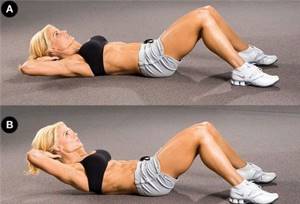
- Now extend your arms along your body and keep them a few centimeters from the floor. With your right hand, stretch to your right heel by bending your lower back to the side. Then repeat the movement for the left side.
- Do 10 times on each side.
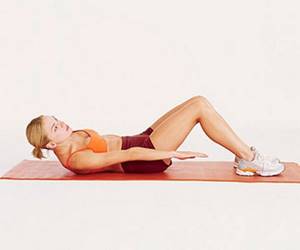
Over time, you will be able to raise your body more relative to the floor. Now we have pumped up the front of the abdomen and sides.
And now the back
Now let's take care of the back. Ideally, do hyperextension in a machine. But if there is no such possibility, we will proceed from what exists. And we have a rug, right?
- Lie on the mat with your stomach down. Extend your arms forward, clasp them palm to palm, as if you are about to dive.
- Bend up slightly so that your body rises slightly off the mat. Hold the tension, then lower back down. Do this 10 times.
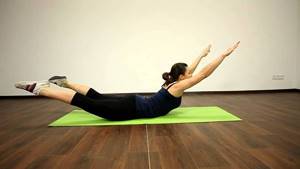
- Get on all fours - support on your knees and palms. Bend your lower back as far as possible, raising your head. Now, on the contrary, round your back upward and lower your head.
- This movement is called the “Cat Exercise.” Do this 10 times.

- Stand up. Move your pelvis back, bending in the lumbar region. Lean forward as far as your lower back will allow. It shouldn't be rounded. Task number one is to maintain the deflection. Pause at the end point for a second and straighten up. Repeat 10 times.
- If your lower back rounds back while bending, straighten up and start again. This roundness is where most problems arise.
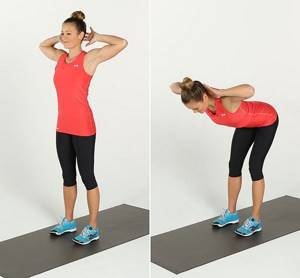
These exercises are aimed at strengthening the lower back and psoas muscles.
Start with 10 reps, gradually increase to 30. Do this every day in the morning.
- Stand with your feet shoulder-width apart. Pull your buttocks back as far as possible (this will create a arch in your lower back). If at the same time you experience pain in the tailbone area and slightly higher, it is too early for you to squat, train according to the previous schemes.
- Stretch your arms in front of you, look at your fingertips. Squat just below parallel to the floor without rounding your back. Pause at the bottom for 1 second and stand up. Please note that during the squat your body does not fall forward. If this happens, spread your legs wider just enough so that you are not leaning more than 20-30 degrees forward.
- The bend in the lower back should compensate for this tilt. As a result, your body is almost perpendicular to the floor.
Exercise “Romanian deadlift”

To begin, stand up straight with your feet shoulder-width apart and your knees slightly bent. The kettlebell should be held in front of the hips with both hands, palms facing inward. If you don't have a kettlebell, you can do this exercise with two dumbbells. This will be the starting position. Next, you need to slightly move your buttocks back, while simultaneously lowering your torso. At the same time, you need to keep your back straight and your shoulders should be pulled back. During the exercise, the torso should be almost parallel to the floor when bending over. Next, you should tense your core, lean on your heels and stand straight, keeping your arms straight. Having risen, you should pause and squeeze your buttocks. This is 1 repetition.
According to the trainer, if during the exercise there is a feeling of tension in the lower back, then it is better to choose a kettlebell or dumbbells of lighter weight. As you work, you should feel more tension in your glutes and hamstrings, although the lower back muscles will also be engaged, but in order to stabilize the core.
The daughter of Konstantin Kinchev has a bright appearance and talent: photo
Fast, tasty and healthy. Egg and Kale Breakfast for a Healthy Morning
“We need to steal less!”: what Vasily Lanovoy considers the main threat to society
More difficult exercises
Next, you can already think about how to work out the lower back with more serious training.
Let's go - hyperextension in the gym!
Hyperextension in the simulator
If you are interested in how to pump up your lower back at home, then you can organize a place for hyperextension on the sofa and ask a second person to help. If this is not possible, go to the gym or do the exercises from the previous section.
So, how to pump up your lower torso using hyperextension while working on a machine.
- Adjust the height of the machine so that your pelvis rests halfway on the support.
- Place your hands on your chest or behind your head. Hold your back so that you get a natural arch in the lower back. Bring your shoulder blades together. Keep your head slightly raised up.
- Lower your torso down to the level until your stretch allows you to maintain the correct arch in your lower back. Rise up to a straight line with your legs.
- Keep your back straight all the time!
Do 1 set of 15 reps for the first time. Then you can add up to 3 approaches.
For abs, practice Roman chairs and leg raises on a bench once a week, but without lifting them vertically to the ceiling.
Lower back exercises don't have to be dynamic. Here, for example, is a plank. You stand for 60-120 seconds on your elbows and toes, keeping your body straight. The same lumbar muscle is tense, the core muscles are tense, all the lumbar muscles are involved so that the pelvis does not fall inward. And the press as an antagonist. Sometimes muscles need such a load.
Side dynamic bar
And one more exercise that is best done by physically advanced people. Both the lumbar muscle and the lateral part of the press work in it. This exercise is similar to a plank, but it is dynamic.
- Stand on your elbow with your side facing the floor. The humerus is perpendicular to the floor. Cross your legs. The initial support points for your body are the elbow and the side of your leg from heel to hip.
- Raise your pelvis up just above a straight line with your body, lower it back down. Start with 10 reps.
- Gradually work your way up to 30. It's not as easy as it seems at first glance.
These exercises can be done three times a week. They will help you build a strong lower back, and if pain bothers you, it will be very, very rare.
I recommend deadlifts only after 3-4 months of strengthening the lower back with exercises like these from all sides.
Sports exercises and tips in pictures and videos

Many athletes want to know how to pump up their lower back muscles at home, because it’s actually simple if you follow the tips and recommendations given below. Of course, only training will allow you to pump up your lower back muscles, but without proper and effective exercises you will not be able to achieve results for a long time.
In this article you will learn how to pump up your lower back muscles at home and what are the effective and best exercises and techniques for this. After all, it’s better to train for a month according to a proven training program and achieve results than to waste a year and never pump up your lower back.
The first thing you need to start with is setting goals correctly. No goal - no motivation, which means no result. Decide what you want to achieve and specifically imagine it in your imagination or find a picture of the already inflated lower back that we dreamed of. Set yourself a specific goal to pump up this lower back by a certain date. Find out: how to pump up your lower back at home or on a horizontal bar.
To pump up your lower back muscles at home, you need to find a suitable room for this, where it will be convenient and comfortable for you to exercise.

You also need to keep a training log in which you will write down all the exercises you will perform, the number of approaches and repetitions. By training according to this training plan, you will see results much sooner.
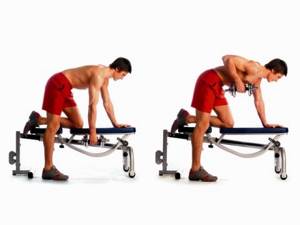
Also make a training schedule. It depends on you whether you will train every day or every other day and on your muscles and how tired they will be. If you can, train your lower back muscles every day, if not, then every other day.

In the evening, it is best to do jogging and strength exercises, so gymnastics and exercises are suitable for the morning, when you just woke up. If you need volume, then train your lower back in the evening; if you just want to stretch and make your lower back healthy, then do yoga, gymnastics or exercises in the morning. Find out: lower back exercises.
To pump up your lower back muscles, you need to lie on your stomach and try to raise your legs as high as possible towards your back. Do 3 sets of 10 repetitions.
Do squats with or without additional weight. To pump up your lower back, you need to do simple squats with or without additional weight. These could be dumbbells or a barbell. The main thing is to keep your back straight during the exercise so as not to injure it.
Pull-ups on a horizontal bar with weights. If you want to pump up your lower back and its volume, you first need to learn how to simply do pull-ups on the horizontal bar at least 10 times, and after that take additional weight and do pull-ups with it. This will help your lower back begin to gain volume and strength.

Push-ups with clapping. To pump up your lower back, you need to try to do push-ups with clapping or just do simple push-ups 50-100 times per set every day.
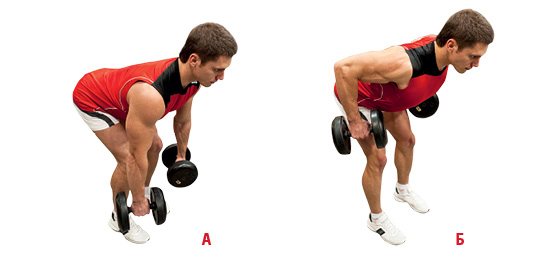
Running in the evenings. It is also good for the lower back to run in the evenings or ride a bike. This will give you more vitality and health and will strengthen and speed up the muscles of the lower back and legs. Find out: gymnastics for the lower back.
To pump up your lower back muscles, you don't need to put a lot of stress on your lower back. Start with simple gymnastics, running in the evenings and cycling.
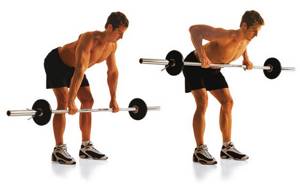
When you are sure that this is easy for you, start doing weightlifting, doing squats, push-ups and pull-ups with additional weight.

But only if you have already started and learned how to properly do pull-ups, push-ups and squats without additional weight.
Make sure you eat right so that your lower back muscles can grow, this requires protein, but don't get carried away with it too much. Eat fish 2 times a week, meat every other day, and also don’t forget to eat 2-3 boiled eggs in the evening.
Do simple gymnastics or fitness, as the lower back does not need a lot of stress to avoid injuring it.
General anatomy
Before choosing exercises to strengthen your back muscles, let's understand the anatomy of this part of the body. As with the pecs, the back is not one muscle, but a group of different muscles responsible for different joints. Most of them are deep back muscles, responsible for fine motor skills of the torso. It makes no sense to train them separately, since they are already involved in almost all exercises to strengthen the back.
If you do not take into account the deep muscles, then all the back muscles can be divided into several groups:
- The latissimus dorsi muscles are responsible for bringing the arms together. They consist of two bundles: the middle one (responsible for the thickness of the back) and the lateral one, located next to the serratus muscles (responsible for the appearance of the so-called “wings” of the athlete).
- The rhomboid muscles of the back are located in the upper layer and run along the entire back. Responsible for retracting the scapula backwards. Consist of three different beams, each of which works with any movement.
- Trapezius muscles of the back. Responsible for rotation in the shoulder joint. They consist of three beams: middle, upper and lower.
- Lumbar muscles. Despite the fact that they cannot be called the largest, they are responsible for stabilizing the body and require separate in-depth study, because form a muscular corset that holds the human body in a straight position. Participate in almost all exercises as a fixing stabilizer of the body.
- The trunk extensor muscles are thin muscles that run along the entire spine. Correct posture and keep the body straight. Participate in all types of rows with a tilted body.
To work all these muscle groups, you need an integrated approach. In this case, it is advisable to work each muscle group from different angles, which will ensure local growth of the muscle group.
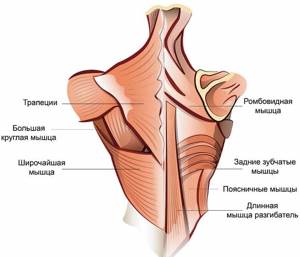
Exercises for the back muscles: specifics and subtleties
Human posture is the façade of the soul.
Baltasar Gracian y Morales, Spanish philosopher
Physical exercises in the gym, in the pool and at home for back health are complexes consisting of specific exercises aimed at stimulating blood and lymph flow in adjacent tissues along the entire length of the spinal column. They strengthen the muscle corset, ligaments, tendons, while giving them elasticity. They are performed with special equipment (gymnastic stick, fitness ball, expander, elastic roller) or weights (weights, dumbbells, barbells or weights). In all back exercises, without exception, technique is of paramount importance.
After I tried almost all the main complexes for strengthening the back, the conclusion came to me: training with your own weight, provided that the exercises are performed correctly, understanding the biomechanics and purpose of each movement, can be no less effective than training with weights.
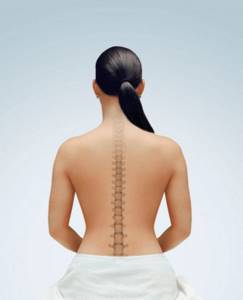
Beautiful posture is a derivative of a healthy and strong back
General recommendations for back training
The general principles of back pumping are very specific and require strict and strict adherence to certain rules.
- Do not use basic exercises in the first months of training. The reason is that under large muscle groups lie a huge number of small muscles, which are easy to injure if the muscle corset is not developed enough. This is why any trainer will recommend using back exercises with dumbbells or exercises on a block machine in the first month in the gym. Isolation load allows you to use fewer small muscle groups and has a fixed amplitude, which is safe when working with light weights. Only when you have prepared your muscle corset for serious loads can you proceed to the classics in the form of deadlifts and bent-over rows.
- If you want to increase the result of the deadlift, do not use the deadlift. No matter how strange it may sound, the most powerful exercise for the back muscles - the deadlift - does not allow for a constant progression of loads. This is because the psoas and accessory muscles tire faster than the rhomboids. Therefore, if you have hit a strength plateau, you should work on all the auxiliary back exercises in the gym and only then return to the deadlift.
- Strict technique. Unlike strained muscles of the arms or legs, sprains and micro-dislocations of the back are fraught with prolapse of a hernia or problems with the spine in the future. It is better not to chase weights and not to perform exercises in the borderline technique: this is dangerous to your health.
- Large muscles respond well to heavy weights. Even if constant growth is not your goal, remember that high repetitions with low weight will not help train your back.
- Do not use a safety harness. Although this is an important safety feature in training, the belt restricts movement in the lower back, causing the psoas and back extensor muscles to stop participating in the exercise. It is better to use lighter weights and choose a smoother progression of loads.
- Base + insulation. Like any other large muscle group, the back is trained in 2 stages. First, basic pre-exhaustion with extremely heavy weights, then targeted strengthening of the muscle group in the simulator. This provides greater load, and therefore greater hypertrophy.
- Don't use two basic exercises on the same day. Avoid combining deadlifts and bent-over rows, as well as deadlifts and sumo rows.
How to strengthen your back muscles
The back is an important part of the human body, thanks to which all people are able to walk on two legs and support the weight of the entire torso. Therefore, it is so important that the muscles in this area and the spine are properly developed. For these purposes, special workouts have been created that should be performed in the gym. At home, it is not always possible to achieve an effective load on the muscles. Instructors do not recommend that beginners immediately perform a standard training course, but rather develop basic back exercises to begin with.
A healthy diet plays an important role when playing sports. Working out on machines in the gym takes a lot of energy, which needs to be replenished correctly. Protein and carbohydrate-free foods promote muscle growth. Suitable:
- fish meat;
- chicken breast;
- cottage cheese (low-fat);
- eggs;
- kefir;
- milk;
- vegetables.

Basic exercises in the gym
Before you start working your back in the gym, you should know what muscles help support the spine. They are divided into three groups:
- trapezoidal;
- latissimus (“wings”);
- rectifiers
The remaining muscles of the back (rhomboformes, teres and serratus), be that as it may, are involved in all major movements. Standard exercises for strengthening the muscles in the spine in the gym help not only to acquire a slender body, but also contribute to weight loss, as well as correction of scoliosis. The basic exercise program includes:
- Pull-ups. Those who want to have a strong torso cannot do without this activity. Pull-ups help build your lat muscles and are especially effective when done with a wide grip.
- Deadlift. A difficult basic back exercise in the gym, thanks to which not only the muscles of the back of the torso are pumped, but also almost all parts of the body. Deadlifts strengthen the trapezius and erector spinae. The technique is simple: straighten up, holding the barbell with outstretched arms from the starting position (back bent towards the lower back, head looking forward, shoulders and chest held straight).
- Bent-over barbell row. The workout will help give the back surface of the body visible volume and pump up the latissimus, rhomboid and trapezius muscles. Execution technique: hold the barbell with an overhand grip, being in the “body forward, knees bent” position, while exhaling, pull the barbell to your chest, pressing your elbows to your torso.

Exercises for the latissimus dorsi muscles
The key to an athlete’s ideal figure is pumped up latissimus dorsi muscles. They are also called “wings”. In order to pump up this muscle group, it is not necessary to use a special back exercise machine. Wide-grip weighted pull-ups are great. These exercises are good as a warm-up - before the main workout, it is advisable to perform two sets of 10 times.
Another exercise to strengthen the back (latissimus muscles) is variations of deadlifts (deadlifts, bent-overs, vertical ones). The work involves using special machines or barbells. A useful exercise would be to pull the upper block to the chest. To perform this back exercise in the gym:
- Go to the sports equipment, install the handle (straight).
- Sit on a bench and support your legs with bolsters.
- Take the handle with a wide straight grip.
- Begin to pull the bar toward your chest as you exhale, squeezing your shoulder blades together.
- Slowly return the bar to the starting position.
- Repeat as many times as required.
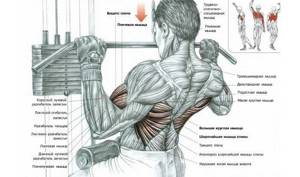
Back exercises with dumbbells
Dumbbells provide great assistance in pumping the muscles of the back of the body. The good thing about these sports equipment is that all the exercises for the back muscles can be done at home. The main thing is to remember the basic truths:
- Perform all movements smoothly;
- keep your lower back straight;
- use your hands less, focus on your back.
- Apple puree: recipes
- Why do fingers crack and how to treat them?
- Diaskintest - what is it: how it is done, results
Back exercises with dumbbells, which must be performed slowly in four sets of 12 times:
- Waist row: stand as straight as possible, lean forward, keep your spine straight, and slightly bend your knees. Pulling your elbows toward your waist, bend your arms with the apparatus so that your shoulder blades come together. Do the reps.
- One-arm dumbbell row. Secure the back of your body by placing your palm and knee on the bench. Grasp the projectile with one hand. Pull the dumbbell as high as possible towards your torso. Return to the starting position. Repeat these back exercises in the gym on your other arm.

Exercises to strengthen the lower back
A back exercise in the gym like hyperextension is a great way to strengthen your lower back. Technique for performing an exercise using body weight:
- Position yourself face down on the machine.
- Secure your legs with a special roller.
- Place your hands behind your head.
- Stay straight and begin to slowly lower your torso down.
- Slowly return to the starting position and hold (1-2 seconds).
- Perform 2-3 sets of 12 reps.
Such back exercises in the gym may seem difficult for the fair sex. There are other lightweight activities to strengthen the lumbar region. Back training for girls is performed without exercise equipment, using a special mat:
- Gymnastic bridge. This simple exercise strengthens the core by partially stretching the muscles. An additional advantage of the bridge is the alignment of the spine along the vertical axis. The technique is simple: while standing on your feet, you need to bend so that you can simultaneously stand on your hands, leaning over yourself.
- Gymnastics video. An excellent tool for pumping up the muscles of the lumbar region and abs. It is necessary to place your knees on a soft surface and, holding the handles of the roller with both hands, roll forward to the maximum distance.

Spinal trainers
Exercises for losing weight on the back and strengthening the spine are best performed using special exercise equipment. They can have different types and technical characteristics. It all depends on which parts of the back of the torso a person wants to pump up. Before use, be sure to consult with a trainer. In gyms you can see the following equipment:
- for unloading and straightening the spine;
- different types of rods (upper, lower, side);
- rod machine and others.
The gyms are equipped with a large number of modern sports equipment that will help pump up your back. The muscles of the back of the torso consist of large muscles, so they need a special load. It is best to work with traction machines and barbells in the gym. It is very important to perform the movements slowly and methodically to avoid serious injury. Loads must be increased gradually. Helpful advice: you should start and end all workouts in the gym with a light warm-up aimed at stretching your muscles.
How to train in the gym
If you choose a split program for training, then your back is trained in one session with other parts of the body. In one day you can work out your legs, triceps, shoulders, and biceps. If your work outside the gym can be called hard, then during training you should do no more than four sets in one training session. If your lifestyle is less active, then you can train up to eight sets per workout.
It is believed that back exercises very often lead to various types of injuries, because spinal injuries can even lead to disability. Also very often problems such as pinched spinal cord, osteochondrosis, spondylolisthesis and spinal hernia can occur. All this can be caused by an incorrect training program where the loads are not calculated correctly.
If you are a beginner, then it is worth taking small weights at the beginning, even if you are very confident in your abilities and can lift much more. The thing is that before serious loads it is worth strengthening the corset of the muscles and ligaments of the body, this will primarily help protect the spine from injury.
To achieve good results, three exercises per workout is enough. To improve the relief and increase muscle mass, ten to fifteen repetitions are enough. To work on strength, the repetitions are reduced to seven.
Exercise results
If the complex is chosen correctly, performed regularly and with full dedication, it will definitely bring benefits. The result of quality training will be:
- strengthening the muscle corset;
- activation of metabolic processes;
- improved digestion;
- beautiful posture;
- relief from back pain caused by sedentary work.
Deterioration in well-being and various kinds of complications during training can only occur in the case of incorrectly selected exercises, existing contraindications, or overtraining. In general, dosed exercise is the most effective and safe way to get in good physical shape, get rid of many diseases and prevent their occurrence.

A healthy back is beautiful and always fashionable
Workouts for the lats
The latissimus muscles can be called the main ones in the formation of the back. These muscles are located in the back of the body, they start from the armpits and go towards the pelvis. Thanks to them, the back gets the appearance of a cone, which makes the waist narrow and the shoulders wide. Therefore, for many athletes, the back muscles are very important in training. This is a lifeline for those who suffer from narrow shoulders; if you work correctly on the lats, the problem will be completely solved.
- Bent-over row with barbell
The deadlift can be called one of the best for building lats. It is advisable to perform it while leaning against a stand with a soft base to prevent cheating. Many people believe that holding the barbell high to the chest will help to better increase the size of the upper parts of the muscle. To develop the lower parts of the muscle, you should lift the barbell towards the stomach, which is located at the waist.
You can also do it with dumbbells. It is advisable to start with light weights. There should be no more than fifteen repetitions.
- Bent-over row with a dumbbell in one hand.
If the technique is fully followed during execution, then it helps to give full load to the latissimus muscle, this helps to obtain contraction, flexibility and stretching. It is advisable to start with the weaker hand. Do the number of repetitions that are necessary on it, repeat the same on your strong hand. This will help make the training more harmonious.
This is a very good exercise that is considered basic. Can be performed with different grip options, where the main role is played by its width. But it is worth knowing that too wide and too narrow a grip can make the lats work worse. To make the training ideal, you should place your hands a little wider than your shoulders. Pull-ups are a good way to diversify your workout and improve the load on the lower back. In some cases, a belt for weightlifters is used for weighting, to which you can attach any weight in the form of a disc from a barbell or a dumbbell. This training is also very relevant on the horizontal bar at home.
This is much more convenient than pull-ups; it is convenient because the angle of the pull can be shifted in the direction you need, which helps work the whole variety of muscle bundles.
- Rows to the block to the waist while sitting.
This is a base that helps to tense a very large array of muscles, which includes the large muscles, lats and pecs. The pull helps give width. It is more effective to use a forked handle, which allows the hands to be parallel.
Trapezius muscles
Muscles of this kind originate at the base of the head, go towards the shoulders and descend towards the waist between the shoulder blades. They play a very important role in the work of an athlete. If these muscles are poorly developed, then we can assume that harmony in the figure cannot be achieved.
Shrugs can be done with both a barbell and dumbbells; they are considered the most effective for working on the trapezius. It is advisable to perform shrugs with the tool lowered down and with straight arms. To do it technically correctly: pick up weights. They try to raise their shoulders as high as possible, without bending their arms. Then they very smoothly return to the starting position.
Lower back exercises
The lower part can be called the lower back, which is equipped with rectifiers. In terms of training, you should leave this part of the body for last. Strengthening the lower back is very useful for health purposes, since this part can be classified as an athlete’s weak points. If the lower back is properly trained, diseases such as osteochondrosis and scoliosis can be avoided. For those who are just beginning to learn the basics of bodybuilding, there is a deadlift that pumps up all the back muscles.
This exercise is quite complex and it works a lot of muscles; it is considered a basic one. Deadlifts are an excellent tool for developing not only your back, but also your legs and arms. This training is very optimal for strengthening the muscles of a beginner. Also, deadlifting won't hurt professionals, at least sometimes. But if there are lagging types of muscles, then it is better to use isolation exercises.
- Bend forward with a barbell.
This type of training is very good for the lumbar area and is considered one of the best for this area. It is advisable to perform it when the training comes to its logical conclusion. The back should be straight and the knees almost turned off. The tilt should be done as long as it is possible to leave your back in a straight position; as soon as it is no longer possible to comply with this rule, you should return to the starting position, as this is fraught with injury.
This training has a great effect on the thickness of the rectifiers, and the muscles of the buttocks and thighs are also included in the work. The exercise is not dangerous and does not put a lot of stress on the joints. Muscle tone and a spinal corset made of tendons develop very well. All this says that hyperextension is very suitable for those whose back can be called weak. The spine and tendons are not at risk of injury.
Exercises for weight loss
Very often used by girls who strive to lose excess weight and the back in this process is no exception. This training is also suitable for men.
No. 1 Take a position lying on your stomach, holding dumbbells with light weight in your arms outstretched in front of you. Lift your torso off the plane on which you are lying, while your arms should be pulled back, return to the lying position.
No. 2 Execution similar to the “swallow” that everyone knows. Take a lying position on your stomach, legs should be straight. The hands move back and the grip is made into the lock. In this position, pull your arms towards the buttocks, and it is advisable to lift your legs off the surface. Try to stay in this position longer. This method is also good for losing weight on your sides.
If you have frequent lower back pain, you can use a fitball; this will help remove unnecessary stress on your back and help improve your health. The fitball is also very convenient to use at home for fitness. This ball is very comfortable for the upper and lower parts. At home, in addition to the ball, dumbbells, and horizontal bar, you can use a kettlebell as weighting.
It is very important to remember that if you suffer from diseases of the spine or other parts, be sure to consult a doctor before exercising. And during periods of exacerbation of diseases, it is advisable to take a break from training. If there are strict contraindications, then it is better to refuse bodybuilding; in such cases, you can use special physical therapy.
Contraindications and restrictions

If there is severe pain in the lower back, the activity should be stopped or the load reduced.
You cannot pump your lower back in the following cases:
- severe injuries of the spine and internal organs, diseases;
- exacerbations of chronic ailments, acute inflammatory conditions;
- for many diseases of the musculoskeletal system, training is indicated, but exercises are chosen taking into account the disorder, for example, in case of a hernia, options with axial load are prohibited;
- You can’t exercise if you have cancer;
- mental and nervous disorders are also a contraindication.
Before starting classes, you should consult with your doctor. If the goal is to improve performance, you need to consult a coach.
